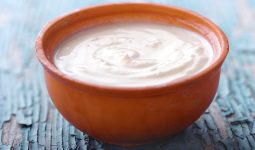Yogurt has become a staple food item in our daily lives. It is a good source of protein and calcium and contains probiotics, beneficial bacteria that aid digestion and boost immunity.
Both children and adults can enjoy this delicious dairy product. However, you may come across different types of yogurt in the supermarket.
There are so many options for yogurt, from plain Greek yogurt to flavored yogurts. Although they all taste great, each variety is unique.
It’s essential to familiarize yourself with the different types of yogurt available to know which is best for your meal and health.
Here are some common types of yogurt;
1. Plain Yogurt
Plain yogurt is usually made from milk or cream and contains no additives or preservatives. This type of yogurt is perfect for breakfast or as an appetizer, and you can eat it by itself or add other toppings such as fruit, granola, nuts, honey, etc.
2. Greek Yogurt
Today’s most prevalent type of yogurt, Greek yogurt, is thicker than regular yogurt. Its primary ingredients are milk and live cultures (which are beneficial to the health of your gut). It is also used in salads, sandwiches, and desserts.
Greek yogurt is strained after it’s been fermented, removing the whey liquid and thickening the yogurt. This makes it taste sourer than regular yogurt (unless flavors and sugars are added). It is often served with fruits like strawberries or blueberries.
3. Flavored Yogurt
Flavored yogurt is essentially plain yogurt with added flavor. Various types of yogurt are available on the market, including chocolate, strawberry, vanilla, and even coffee. These flavors appeal to kids and adults alike and are perfect for snacks, desserts, or toppings for ice cream.
4. Frozen Yogurt
Frozen yogurt is similar to frozen custard but without eggs. Instead, it uses gelatin to thicken the mixture, and it is creamier and less icy than traditional frozen yogurt. Some people prefer it because it doesn’t have any added sugar.
Since this yogurt does not contain eggs, it’s considered a healthier option than other yogurt types. It is also lower in calories and fat compared to regular yogurt. However, if you want something sweet, this is the right choice.
5. Australian Yogurt
Thickness is why Australian yogurt is often compared to Greek and Icelandic yogurt. However, there is one significant distinction.
A thicker texture is achieved during fermentation by not straining it and cooking it longer, and whole milk is usually used to achieve the desired level of creaminess.
6. Icelandic Yogurt
Ice-Cream-Like Yoghurt: Icelanders love their dairy products. They consume almost twice as much butter as Americans do. This is why they make some of the best cheeses and yogurts in the world.
Their yogurt has a thick consistency that resembles ice cream. It is usually eaten plain, but you can mix it with berries or other ingredients.
Icelandic yogurt is a great way to get your daily dose of calcium. It also contains probiotics that help promote good gut health. It is low in calories and fat and high in protein, making it an ideal snack for weight loss that can be eaten alone or mixed into smoothies.
7. Probiotic Yogurt
Probiotics are live bacteria that help maintain healthy digestion and are found naturally in dairy products, vegetables, and meat. When consumed regularly, probiotic yogurt has been proven beneficial. This type of yogurt helps improve digestive health and boost immunity.
8. Non-dairy Yogurt
Non-dairy yogurt is made from soybeans instead of milk, making it an excellent alternative for those who cannot consume dairy products due to allergies or other reasons.
9. Swiss Yogurt
Swiss yogurt is a delicious, thickened form of Greek yogurt. It is available in plain varieties with no additives, and the texture is slightly thicker than regular yogurt, and it usually comes in smaller containers. It is often used in desserts and baked goods.
10. Kefir
Kefir is a fermented drink that originated in Eastern Europe. It is a yogurt-like beverage produced by milk fermenting kefir grains (symbiotic culture of yeast and lactic acid bacteria).
11. Lassi
Lassi is a traditional Indian dish made from yogurt and spices, and it is served chilled and traditionally drunk after meals. It is sometimes served with fruit, but it’s also enjoyed independently.
Lassis are typically sweetened with sugar and flavored with cardamom, cinnamon, ginger, cloves, coriander, cumin, saffron, tamarind, rose water, lemon juice, lime juice, or orange juice.
12. Doogh
Doogh is a popular non-alcoholic Persian beverage. It is similar to the Turkish kadayif and is commonly consumed as a refreshing drink during hot weather. Doogh is made from yogurt and water and is not strained.
13. Goat’s Milk Yogurt
Goat’s milk yogurt is a creamy dairy product made from goat’s milk, and it has a milder flavor than cow’s milk yogurt. It is a versatile food and can be used in many different recipes.
14. Sheep’s Milk Yogurt
Sheep’s milk yogurt is a creamy, tangy dairy product made from sheep’s milk. It has a more pungent taste than cow’s milk yogurt and is rich in protein and calcium.
This type of yogurt also has more fat than regular yogurt and is thicker. It is often sold in tubs rather than individual containers.
15. French-style Yogurt
The term “French-style yogurt” refers to yogurt made in smaller quantities. Fermentation occurs in individual containers rather than a large batch of milk fermented and then divided.
Often, it’s sold in the container it was made in. It is the same way that traditional cow’s milk is unstrained with this product.
Yogurt made from goat’s milk has a more delicate, rich, and less sweet texture than yogurt made from cow’s milk.
16. Soy Yogurt
Soy yogurt is a thick liquid yogurt made from soybeans, and this may be the closest non-dairy yogurt to the texture and thickness of traditional cow’s milk yogurt.
It is usually available in small cartons at grocery stores. It is an excellent source of protein and contains no cholesterol.
Vegans love it, and it’s one of the more readily available dairy-free yogurt options. It has a mild sweetness, similar to soy milk, and like traditional plain yogurt, it also has a tangy flavor.
17. Almond Yogurt
Almond yogurt is a smooth, creamy, tart yogurt made from almonds. After heating and thickening almond milk, live cultures are added to create almond yogurt at the end of the process.
Traditional yogurt is denser, but the flavor and texture are very similar, and some tartness and a hint of sweetness are present.
18. Cashew Yogurt
Cashew yogurt is well-known for its silky texture. Cashews and probiotics are soaked and blended before being added to the mixture, which is then allowed to thicken (sometimes using heat).
It can be used as a spread or dip for slices of bread, crackers, or other foods. This is a great plant-based substitute if you don’t want to use natural cream in your dips and sauces.
However, it can taste acidic if not sweetened or mixed with other ingredients and flavors.
19. Coconut Yogurt
Coconut yogurt is a popular coconut milk beverage in many different varieties. The most common type is the coconut water version, filtered coconut water.
Other versions include coconut milk and coconut cream. This dish uses coconut milk and coconut cream interchangeably, depending on the occasion.
Furthermore, this type of yogurt usually has a hefty calorie and fat content, depending on the brand, but it’s a delicious treat nonetheless.
20. Low-fat Yogurt
Low-fat yogurt is a good option for those who want to lose belly fat. Because it has fewer calories, low-fat yogurt is recommended.
However, low-fat yogurt isn’t always sugar-free, so you must be careful. Because of its lower fat content, this yogurt lacks the mouthwatering flavor of its full-fat counterpart.
As a result, some companies now add sugar to their products to maintain their delicious taste.








